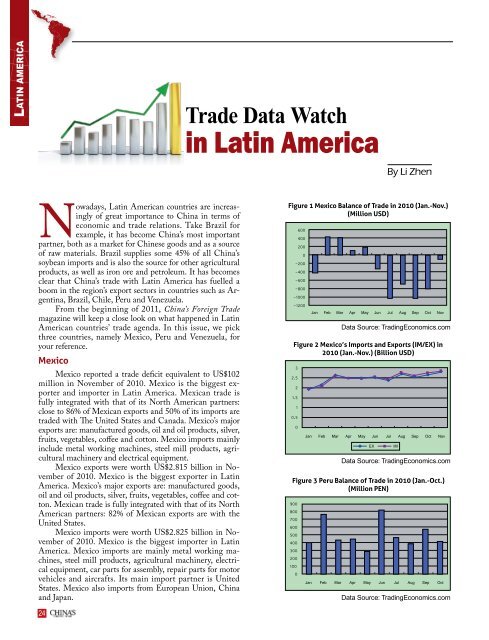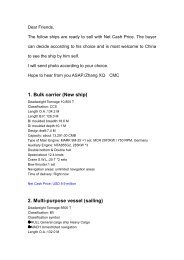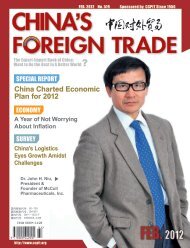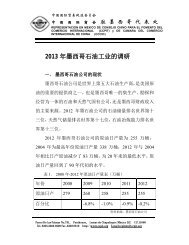You also want an ePaper? Increase the reach of your titles
YUMPU automatically turns print PDFs into web optimized ePapers that Google loves.
Trade Data Watch<br />
in Latin America<br />
By Li Zhen<br />
Nowadays, Latin American countries are increasingly<br />
of great importance to China in terms of<br />
economic and trade relations. Take Brazil for<br />
example, it has become China’s most important<br />
partner, both as a market for Chinese goods and as a source<br />
of raw materials. Brazil supplies some 45% of all China’s<br />
soybean imports and is also the source for other agricultural<br />
products, as well as iron ore and petroleum. It has becomes<br />
clear that China’s trade with Latin America has fuelled a<br />
boom in the region’s export sectors in countries such as Argentina,<br />
Brazil, Chile, Peru and Venezuela.<br />
From the beginning of 2011, China’s Foreign Trade<br />
magazine will keep a close look on what happened in Latin<br />
American countries’ trade agenda. In this issue, we pick<br />
three countries, namely Mexico, Peru and Venezuela, for<br />
your reference.<br />
Mexico<br />
Mexico reported a trade deficit equivalent to US$102<br />
million in November of 2010. Mexico is the biggest exporter<br />
and importer in Latin America. Mexican trade is<br />
fully integrated with that of its North American partners:<br />
close to 86% of Mexican exports and 50% of its imports are<br />
traded with The United States and Canada. Mexico’s major<br />
exports are: manufactured goods, oil and oil products, silver,<br />
fruits, vegetables, coffee and cotton. Mexico imports mainly<br />
include metal working machines, steel mill products, agricultural<br />
machinery and electrical equipment.<br />
Mexico exports were worth US$2.815 billion in November<br />
of 2010. Mexico is the biggest exporter in Latin<br />
America. Mexico’s major exports are: manufactured goods,<br />
oil and oil products, silver, fruits, vegetables, coffee and cotton.<br />
Mexican trade is fully integrated with that of its North<br />
American partners: 82% of Mexican exports are with the<br />
United States.<br />
Mexico imports were worth US$2.825 billion in November<br />
of 2010. Mexico is the biggest importer in Latin<br />
America. Mexico imports are mainly metal working machines,<br />
steel mill products, agricultural machinery, electrical<br />
equipment, car parts for assembly, repair parts for motor<br />
vehicles and aircrafts. Its main import partner is United<br />
States. Mexico also imports from European Union, China<br />
and Japan.<br />
Figure 1 Mexico Balance of Trade in 2010 (Jan.-Nov.)<br />
(Million USD)<br />
600<br />
400<br />
200<br />
0<br />
-200<br />
-400<br />
-600<br />
-800<br />
-1000<br />
-1200<br />
Jan<br />
Feb Mar Apr May Jun Jul Aug Sep Oct Nov<br />
Data Source: TradingEconomics.com<br />
Figure 2 Mexico’s Imports and Exports (IM/EX) in<br />
2010 (Jan.-Nov.) (Billion USD)<br />
3<br />
2.5<br />
2<br />
1.5<br />
1<br />
0.5<br />
0<br />
Jan Feb Mar Apr May Jun Jul Aug Sep Oct Nov<br />
Data Source: TradingEconomics.com<br />
Figure 3 Peru Balance of Trade in 2010 (Jan.-Oct.)<br />
(Million PEN)<br />
900<br />
800<br />
700<br />
600<br />
500<br />
400<br />
300<br />
200<br />
100<br />
0<br />
Jan Feb Mar Apr May Jun Jul Aug Sep Oct<br />
EX<br />
IM<br />
Data Source: TradingEconomics.com<br />
24

















